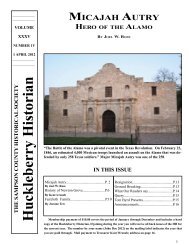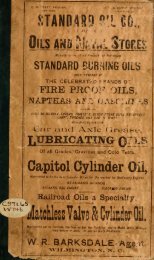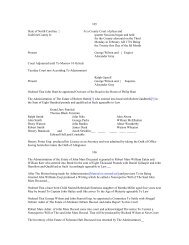11/25/07 VERSION: BEDSOLE HISTORY FROM 1673 ... - NCGenWeb
11/25/07 VERSION: BEDSOLE HISTORY FROM 1673 ... - NCGenWeb
11/25/07 VERSION: BEDSOLE HISTORY FROM 1673 ... - NCGenWeb
You also want an ePaper? Increase the reach of your titles
YUMPU automatically turns print PDFs into web optimized ePapers that Google loves.
ship to look, with the joyful thought that this total nightmare was about to end. Little<br />
did they know their nightmare was only just beginning.The ship approached land<br />
cautiously, the captain not being certain of the exact layout of the body of land the<br />
Lookout had spotted. Searching for the mouth of the Pamlico River and a fort with<br />
more than a hundred earlier settlers already there, was not easy, with no<br />
navigational methods, except intuition and memory. He ordered the crew to lower<br />
sails and drop anchor, to allow an exploratory party on a dinghy to paddle closer in<br />
to the shallower water and get a look at the land. Suddenly, from around a finger of<br />
land, sailing towards the English ship, was a Spanish Man-O-War ship, bristling with<br />
deck cannons. Upon seeing the English ship, the Spanish commander, ordered his<br />
crew to lower sails, come to a halt and drop anchor, perhaps 2,000 feet away, and<br />
then dispatched two row boats to the English ship for boarding and investigation.<br />
However, the English captain indicated his ship was english, in free waters, and not<br />
subject to any authority of the Spanish king, and ordered his crew to fire on the<br />
Spanish ship with two of the deck cannons. The two shots missed.<br />
The fire was answered almost instantly, with a volley from the Spanish ship, with one<br />
of the shells striking the main mast of the English ship, causing it to drop to the deck,<br />
killing three of the settlers and injuring 3 others, who had gathered to watch the<br />
confrontation. Working desperately to bring its cannons to bear amid all the<br />
tied-down household goods on deck, the English ship returned fire, but this time with<br />
five deck cannons. Two of its shells struck the Spanish ship almost amidship and<br />
severely damaged the vessel. With that, the Spanish captain waved the white flag,<br />
indicating surrender, but the English captain, not wanting to incur the problem of<br />
having to control the Spanish crew while trying to deliver the settlers to land, ordered<br />
a hasty departure from the area, picking up his exploratory boat and crewmen before<br />
doing so.<br />
Continuing his slow search, for the mouth of the River, the ship finaly approached<br />
the entrance and continued sailing up the river. They eventually approached a<br />
wooden fort, triangular in shape, measuring four hundred feet by four hundred feet<br />
by four hundred feet, constructed of logs set into the ground with sharpened tops<br />
pointing skyward and within which there were sixteen small, one-room log cabins<br />
with dirt floors.<br />
At each of the 3 points on the forts triangular walls were guard and lookout towers<br />
for protection against marauding Indians who attacked them from time to time.<br />
Within the fort, there were perhaps seventy-five surviving settlers and outside its<br />
walls, the remainder, wildly cheering, shouting and waving a welcome to the ship<br />
and its newcomers, in the mistaken belief that the ship carried food, medicine and<br />
supplies for the forts current occupants. The captain ordered his crew to lower the<br />
sails and drop anchor, in six fathoms, thirty-six feet, of water, about 300 feet from<br />
shore.<br />
The captain ordered the rowboat lowered and again three crewmen were sent










